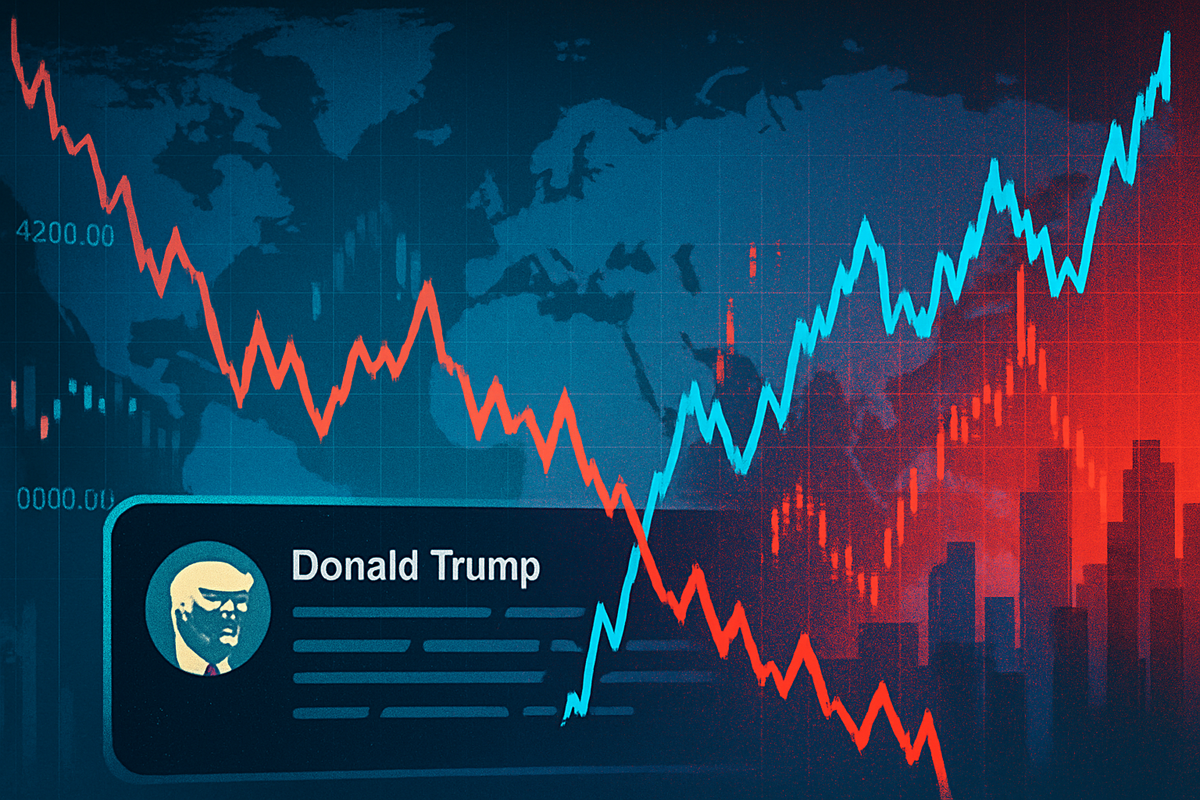Financial News
Trump's Truth Social Roars: How Presidential Posts Send Shockwaves Through Global Markets

President Donald Trump's social media pronouncements continue to be a dominant force in shaping global financial markets, proving that even outside the Oval Office, his words can trigger immediate and often dramatic shifts in investor sentiment and stock futures. As of October 2025, his posts, particularly on trade and monetary policy, have demonstrated an unparalleled ability to move markets, creating significant volatility and requiring investors to remain hyper-vigilant to his digital footprint. The direct correlation between a Trump post and market reaction underscores a new era of political influence on financial stability, where a single statement can wipe out or create billions in market value within hours.
A Digital Baton Conducting Market Swings
The most recent and striking examples of this influence occurred in October 2025. On October 10, President Trump took to Truth Social, threatening a "massive increase" in tariffs on Chinese imports, citing China's "hostile" export controls on rare earth minerals. The market's response was swift and severe: US stock markets tumbled, with the S&P 500 plummeting 2.7%, the Nasdaq 100 losing 3.5%, and the Dow Jones Industrial Average shedding 1.05%. This sell-off marked one of the worst days for US stock markets since the COVID-19 pandemic for some indices. Commodity markets also felt the sting, with copper prices on the London Metal Exchange (LME) (LME: HG1) dropping 4.9%, its largest single-day decline in five months, while aluminum, platinum, and palladium also saw significant losses. In a classic flight to safety, gold futures (COMEX: GC00) gained 0.09%, and US Treasuries rallied as investors sought refuge from heightened uncertainty.
However, just two days later, on October 12, President Trump again used Truth Social to issue conciliatory remarks, stating, "Don't worry about China, it will all be fine! Highly respected President Xi just had a bad moment," and that the U.S. "wants to help China, not hurt it." This sudden shift in tone led to an equally swift rebound in Wall Street stock index futures, with S&P 500 futures climbing 0.9%-1.1%, Nasdaq 100 futures surging 1.2%-1.6%, and Dow futures gaining 0.6%-0.7%. This immediate reversal powerfully illustrates the direct and almost instantaneous impact of his social media posts on investor sentiment.
Earlier in 2025, on April 2, President Trump's announcement of sweeping tariffs on countries with a trade deficit with the US, dubbed "Liberation Day," triggered widespread panic selling across global stock markets. This event became the largest global market decline since the 2020 COVID-19 crash, with the S&P 500 (NYSEARCA: SPY) dropping by 10% and the VIX (CBOE: VIX) spiking to 45.31. The administration's subsequent pause on some tariff increases on April 9 led to a significant stock market rally. Moreover, throughout 2025, Trump's posts have also been noted for influencing market expectations regarding Federal Reserve policy, with his public pressure for interest rate cuts leading investors to price in potential regulatory shifts and trade war risks, as high-frequency analysis in August 2025 showed each of his tweets leading to a -0.26 basis point downward revision in fed funds rate expectations.
Corporate Fortunes in the Crosshairs: Winners and Losers in a Volatile Market
President Trump's trade and monetary policy statements in 2025 have created a clear divide in corporate fortunes, with some sectors and companies facing significant headwinds while others find unexpected tailwinds. The "America First" approach, characterized by aggressive tariffs and outspoken criticism of the Federal Reserve, has forced businesses to re-evaluate supply chains, production strategies, and market exposure.
The technology sector, heavily reliant on global supply chains and manufacturing in China, has been particularly vulnerable. On October 10, 2025, following Trump's 100% tariff threat on Chinese goods, giants like Apple (NASDAQ: AAPL) saw its stock plunge, erasing billions in market value due to concerns over higher production costs and supply chain disruptions. Nvidia (NASDAQ: NVDA) experienced a nearly $229 billion decline in market capitalization on the same day, as its crucial AI model GPUs are reliant on supply chains potentially impacted by Chinese rare earth restrictions. Other tech behemoths like Amazon (NASDAQ: AMZN), Tesla (NASDAQ: TSLA), Microsoft (NASDAQ: MSFT), and Alphabet (NASDAQ: GOOGL) also collectively lost hundreds of billions in value, highlighting the sector's sensitivity to trade tensions. U.S.-listed Chinese e-commerce firms such as Alibaba Group Holding (NYSE: BABA), JD.com Inc. (NASDAQ: JD), and PDD Holdings (NASDAQ: PDD) also finished significantly lower following tariff comments.
The automotive sector has also absorbed substantial blows. General Motors (NYSE: GM) reported a Q2 2025 operating profit tumble of approximately 32%, attributing $1.1 billion in extra costs to tariffs, with a forecast of $4 billion to $5 billion for the full year. Stellantis (NYSE: STLA) disclosed absorbing €300 million in tariff impacts in the first half of 2025. Similarly, retail and consumer goods companies like Walmart (NYSE: WMT) trimmed earnings guidance, and Procter & Gamble (NYSE: PG) raised prices, reflecting the increased cost burden. Adidas (OTC: ADDYY) reported a "double-digit million-euro" hit from U.S. tariffs, particularly from goods sourced from Vietnam and Indonesia, while Levi Strauss (NYSE: LEVI) fell significantly after cautious guidance.
Conversely, certain sectors and companies have either benefited or are poised to gain. Domestic manufacturing is a clear beneficiary of the "America First" policy, with companies focused on U.S. production potentially seeing increased demand and reduced competitive pressure. The financial sector, represented by firms like JPMorgan Chase (NYSE: JPM) and Bank of America (NYSE: BAC), is expected to benefit from deregulation policies. The energy sector, including ExxonMobil (NYSE: XOM) and Chevron (NYSE: CVX), anticipates gains from deregulation and a renewed focus on domestic energy production. Perhaps the most direct beneficiaries of the recent trade escalation are U.S.-based rare earth suppliers. Following Trump's October 10 tariff threats against China, companies like MP Materials (NYSE: MP) saw their shares jump 11.07%, and USA Rare Earth (OTC: USAR) gained 15%, as investors sought domestic sources of critical minerals crucial for technology and manufacturing. Additionally, proposed corporate tax cuts to 15% are expected to benefit high-margin companies and those with substantial overseas cash reserves like Apple, Microsoft, and Alphabet, despite their trade-related challenges.
The Broader Implications: Reshaping Global Commerce and Policy
President Trump's influential statements and subsequent policy implementations in 2025 extend far beyond immediate market fluctuations, signaling a profound reorientation of global commerce, industrial strategy, and regulatory landscapes. His "America First" agenda, centered on protectionist trade policies and deregulation, is not merely a series of events but a catalyst for systemic shifts across industries and international relations.
A primary consequence is the accelerated fragmentation of global supply chains. The imposition of universal tariffs, coupled with specific, escalating duties on Chinese goods, is compelling businesses to fundamentally rethink their sourcing and manufacturing strategies. Companies are increasingly prioritizing "just-in-case" logistics over "just-in-time" to build resilience against geopolitical risks, leading to a scramble for diversified or localized production. While this aims to boost domestic manufacturing, it simultaneously increases costs for consumers and businesses globally, contributing to inflationary pressures and disrupting established trade routes. For instance, the auto industry's struggle with increased production costs and the footwear sector's anticipated threats from reliance on Chinese production highlight how deeply ingrained global supply networks are, and how disruptive their forced reconfiguration can be.
In terms of regulatory and policy implications, deregulation remains a cornerstone of the Trump administration. This strategy is expected to foster stronger business investment in the short term, particularly in the financial sector, where looser conditions are anticipated to spur growth. The cryptocurrency industry, for example, has shown sensitivity to this, with Bitcoin prices spiking on election night in anticipation of a more supportive regulatory environment. However, this push for deregulation, particularly in environmental protection, raises long-term concerns about ecological degradation and public health, potentially reversing progress made on climate initiatives. The energy sector stands to benefit significantly from relaxed regulations, with a renewed emphasis on fossil fuel production and exports, likely slowing the transition to renewable energy sources despite robust private investment in clean energy in many regions.
Historically, presidential statements have always influenced markets, but Trump's direct use of social media has established a new precedent for immediate, high-frequency market volatility. Comparisons to historical protectionist measures, such as the McKinley Tariff of 1890 or the Smoot-Hawley Tariffs of 1930, underscore the potential for long-term economic inefficiencies and distortions in resource allocation that such policies can create. These historical parallels serve as a stark reminder of how trade wars can disrupt global trade and contribute to broader economic challenges. The current environment also mirrors past cycles of deregulation, which have often been followed by concerns about financial instability or environmental consequences, suggesting a cyclical pattern of regulatory adjustment in response to perceived excesses.
The Road Ahead: Navigating a Landscape of Volatility and Opportunity
Looking ahead, President Trump's continued influence portends a period of sustained market volatility and profound strategic recalibration for businesses and investors. The short-term outlook suggests immediate market reactions to policy announcements, particularly concerning trade and regulation, while the long-term view points to structural shifts in economic growth, inflation, and sector performance.
In the short term, markets should anticipate continued volatility and inflationary pressures. The rapid implementation of tariffs, such as the universal 10% duty on imports enacted in April 2025 and the escalating tariffs on Chinese goods, is projected to add a "substantial inflationary impulse," potentially increasing core Personal Consumption Expenditures (PCE) inflation. Businesses must prepare for higher import costs, which will likely be passed on to consumers or absorbed, impacting profit margins. Concurrently, a swift wave of regulatory pauses and reversals is expected, particularly in the energy sector, as the administration moves to dismantle previous regulations. The tech industry, while facing issues like the future of TikTok, appears to be adopting a more conciliatory stance, perhaps hoping to influence policy rather than openly oppose it.
Over the long term, the economic landscape is likely to be shaped by persistent inflationary pressures driven by restrictive immigration policies and ongoing tariffs. These factors could reverse decades of downward pressure on prices, leading to "uncomfortable levels" of inflation that might challenge the Federal Reserve's ability to significantly cut interest rates. The protectionist trade stance will continue to drive a redesign of global supply chains, incentivizing domestic manufacturing and potentially leading to a "manufacturing renaissance" in certain sectors, albeit with increased initial costs. Tax policy will also be a major focus, with anticipated extensions of the 2017 Tax Cuts and Jobs Act (TCJA) provisions and potential further corporate tax reductions, which could stimulate investment but also exacerbate the national debt. Businesses will need to prioritize tax planning and advocacy to navigate these changes.
For investors and businesses, strategic pivots are essential. Opportunities will likely emerge in domestic manufacturing and industrials, as "America First" policies aim to bolster local production. The energy sector, particularly fossil fuels, stands to benefit from deregulation and a focus on energy independence, while defense and cybersecurity contractors could see increased demand from higher national security spending. Conversely, challenges will persist, including elevated tariff costs that act as a tax on imports, supply chain disruptions requiring complex redesigns, and the overarching regulatory uncertainty that can deter long-term planning. Companies heavily reliant on globalized supply chains or with significant international operations will need to adapt or face headwinds. The overall market will likely contend with heightened volatility and the need for agile, strategically positioned portfolios to navigate these complex dynamics.
The Enduring Impact and What Lies Ahead
The year 2025 has unequivocally demonstrated President Trump's profound and enduring influence on financial markets. His re-election ushered in initial optimism, quickly followed by periods of intense volatility driven by aggressive trade policies, yet the market has shown remarkable resilience. Key takeaways reveal a market deeply intertwined with presidential rhetoric and policy: immediate and dramatic reactions to social media posts, a significant re-evaluation of global supply chains due to tariffs, and a pronounced shift in regulatory priorities favoring certain domestic industries. Despite sharp downturns, such as the "Liberation Day" market crash in April, U.S. equities have largely rebounded, with strong corporate earnings projected for the year.
Moving forward, the market will continue to navigate a complex environment characterized by robust U.S. economic growth alongside persistent inflationary pressures. The aggressive tariff regime is a direct contributor to this inflation, potentially forcing the Federal Reserve to maintain a cautious stance on interest rate cuts. Investors should anticipate continued divergence in sector performance: domestic manufacturing, energy, financials, and pharmaceuticals are likely to benefit from "America First" policies and deregulation, while clean energy and electric vehicle industries, often reliant on government incentives, may face headwinds. The technology sector, particularly in AI, remains a powerhouse but is highly sensitive to geopolitical developments and trade tensions.
The lasting impact of President Trump's 2025 policies is poised to reshape the economic landscape for years to come. Expect an increased national debt due to extended tax cuts, sustained inflationary pressures from tariffs leading to a potentially higher equilibrium inflation rate, and a fundamentally reshaped global supply chain as companies de-risk and localize production. This era also marks a significant geopolitical realignment, with the U.S. adopting a more insular trade approach, potentially leading to ongoing disputes and increased global volatility. Investors may increasingly adopt a domestically focused strategy while also seeking defensive assets like gold during periods of uncertainty.
In the coming months, investors should vigilantly watch for several critical indicators: the evolution of trade policy, particularly any new tariff announcements or retaliatory measures; inflation data and the Federal Reserve's response, as these will dictate interest rate trajectories; fiscal policy details, including tax legislation and spending programs; and sector-specific performance, identifying which industries are adapting successfully to the new policy environment. Finally, geopolitical developments, especially concerning U.S.-China relations and tensions over critical resources like rare earth minerals, will remain a primary driver of market sentiment and volatility. An adaptive and diversified investment approach will be crucial to navigating this dynamic and politically charged market.
This content is intended for informational purposes only and is not financial advice
More News
View More




Recent Quotes
View More
Quotes delayed at least 20 minutes.
By accessing this page, you agree to the Privacy Policy and Terms Of Service.



